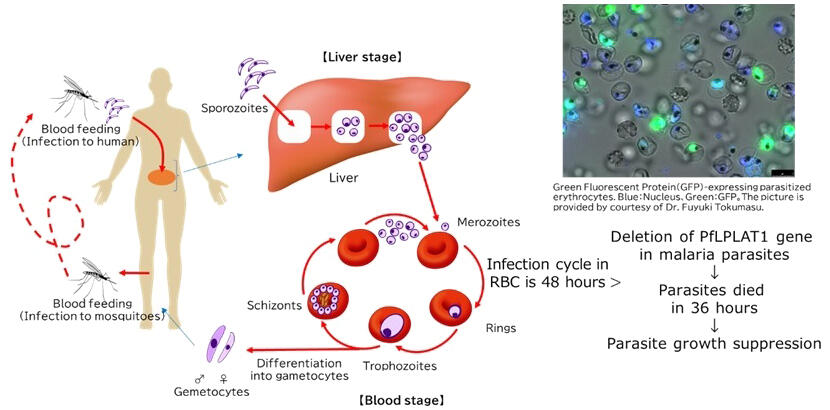On February 14, a research group led by Professor Daniel Ken Inaoka of the Department of Molecular Infection Dynamics, Institute of Tropical Medicine at Nagasaki University, Research Fellow Junpei Fukumoto of the Proteo-Science Center at Ehime University, and Professor Fuyuki Tokumasu of the Graduate School of Health Sciences at Gunma University, in collaboration with the National Center for Global Health and Medicine and Jichi Medical University, has announced that they have identified an acyltransferase (PfLPLAT1) essential for the survival of Plasmodium falciparum. P. falciparum rapidly died when the gene for this enzyme was destroyed. The findings are expected to contribute to the development of new antimalarial drugs and were published in the international journal Communications Biology on January 29.

Provided by Nagasaki University
Malaria is one of the world's three major infectious diseases, affecting about 260 million people and causing 600,000 deaths annually. It is an epidemic mainly in Africa and Southeast Asia. Malaria parasites responsible for the disease are introduced into the human body through mosquito bites. The parasites first multiply in the liver and then invade red blood cells, in which they further multiply before symptoms such as high fever and anemia occur. Infection with P. falciparum poses serious risks, including brain damage, acidosis (excessive acidification of the blood), and severe anemia.
Malaria vaccines are available but are not fully effective and it is difficult to achieve their widespread use. Currently, combination therapies based on artemisinin, which is referred to as the magic bullet, are recommended. However, the emergence of artemisinin-resistant malaria parasites has also been reported.
In this study, the research group focused on the synthesis pathway of lipids that make up the cell membrane of P. falciparum. Large amounts of lipids are synthesized during cell division and proliferation in P. falciparum. However, little research has been conducted on this pathway, and the enzymes in the pathway are poorly understood.
In the phospholipid synthesis pathway, they identified and functionally characterized "lysophospholipid acyltransferase." This enzyme adds another acyl chain to a phospholipid (lysophospholipid) with only one acyl chain (the two carbon chains derived from fatty acids in the phospholipid molecule) to produce a typical phospholipid. Although the activity of this enzyme has been reported at the cellular level, the function of the enzyme itself has never been confirmed.
Therefore, the group performed a gene database search and found a gene of unknown function with structural similarity to the human enzyme (PfLPLAT1). Genetically engineered P. falciparum lines that allow for condition-specific gene disruption were created and used to analyze the enzyme function. The results showed that when this gene was disrupted, the malaria parasite died in about 36 hours, which was shorter than the 48-hour cycle of erythrocytic infection. Meanwhile, forced expression of PfLPLAT1 upon gene disruption rescued P. falciparum from dying. This result indicates that this enzyme is essential for the survival of P. falciparum.
The cells of dying P. falciparum showed the development of major structural defects. The enzymatic activity data revealed that this enzyme can convert multiple lysophospholipids to their diacyl forms and that compositional ratios of multiple molecules in biological membranes are maintained. The lipid synthesis pathway is involved in producing molecules constituting cell membranes and intracellular metabolism. Thus, one can expect an innovation in developing drugs that act on the lipid synthesis pathway to simultaneously disrupt metabolism and structure.
Inaoka said, "The most impactful result is the discovery that the PfLPLAT gene is essential for the survival of the malaria parasite. Since this gene is essential, live malaria parasites could not be obtained by the usual gene disruption method. The analysis finally became possible using a method in which the gene is disrupted only when adding rapamycin. The establishment of this system was the hardest part of the study. The corresponding author, Dr. Tokumasu (Gunma University), is a leading expert on lipid metabolism in malaria parasites. We look forward to developing drug discovery research targeting PfLPLAT and clarifying the roles played by PfLPLAT in various life phenomena, such as the life cycle of this parasite and adaptation to the host environment."
Journal Information
Publication: Communications Biology
Title: Pivotal roles of Plasmodium falciparum lysophospholipid acyltransferase 1 in cell cycle progression and cytostome internalization
DOI: 10.1038/s42003-025-07564-4
This article has been translated by JST with permission from The Science News Ltd. (https://sci-news.co.jp/). Unauthorized reproduction of the article and photographs is prohibited.




